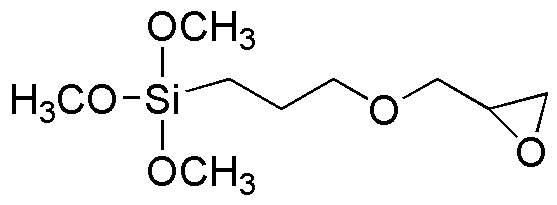3-Glycidoxypropyltrimethoxysilane is widely utilized in research focused on:
- Adhesives and Sealants: This chemical enhances the adhesion properties of various materials, making it ideal for use in construction and automotive industries where strong bonds are essential.
- Coatings: It is used in formulating protective coatings that improve durability and resistance to environmental factors, benefiting industries like aerospace and marine.
- Composite Materials: By acting as a coupling agent, it improves the mechanical properties of composite materials, which are crucial in manufacturing lightweight and strong components for the aerospace and automotive sectors.
- Surface Modification: This compound is effective in modifying surfaces to enhance hydrophobicity or oleophobicity, which is valuable in electronics and textiles.
- Biomedical Applications: Its biocompatibility makes it suitable for use in biomedical devices, particularly in drug delivery systems and tissue engineering, providing advantages over other silanes in terms of functionalization.
General Information
Properties
Safety and Regulations
Applications
3-Glycidoxypropyltrimethoxysilane is widely utilized in research focused on:
- Adhesives and Sealants: This chemical enhances the adhesion properties of various materials, making it ideal for use in construction and automotive industries where strong bonds are essential.
- Coatings: It is used in formulating protective coatings that improve durability and resistance to environmental factors, benefiting industries like aerospace and marine.
- Composite Materials: By acting as a coupling agent, it improves the mechanical properties of composite materials, which are crucial in manufacturing lightweight and strong components for the aerospace and automotive sectors.
- Surface Modification: This compound is effective in modifying surfaces to enhance hydrophobicity or oleophobicity, which is valuable in electronics and textiles.
- Biomedical Applications: Its biocompatibility makes it suitable for use in biomedical devices, particularly in drug delivery systems and tissue engineering, providing advantages over other silanes in terms of functionalization.
Documents
Safety Data Sheets (SDS)
The SDS provides comprehensive safety information on handling, storage, and disposal of the product.
Product Specification (PS)
The PS provides a comprehensive breakdown of the product’s properties, including chemical composition, physical state, purity, and storage requirements. It also details acceptable quality ranges and the product's intended applications.
Certificates of Analysis (COA)
Search for Certificates of Analysis (COA) by entering the products Lot Number. Lot and Batch Numbers can be found on a product’s label following the words ‘Lot’ or ‘Batch’.
Numéro de catalogue
Numéro de lot/série
Certificates Of Origin (COO)
This COO confirms the country where the product was manufactured, and also details the materials and components used in it and whether it is derived from natural, synthetic, or other specific sources. This certificate may be required for customs, trade, and regulatory compliance.
Numéro de catalogue
Numéro de lot/série
Safety Data Sheets (SDS)
The SDS provides comprehensive safety information on handling, storage, and disposal of the product.
DownloadProduct Specification (PS)
The PS provides a comprehensive breakdown of the product’s properties, including chemical composition, physical state, purity, and storage requirements. It also details acceptable quality ranges and the product's intended applications.
DownloadCertificates of Analysis (COA)
Search for Certificates of Analysis (COA) by entering the products Lot Number. Lot and Batch Numbers can be found on a product’s label following the words ‘Lot’ or ‘Batch’.
Numéro de catalogue
Numéro de lot/série
Certificates Of Origin (COO)
This COO confirms the country where the product was manufactured, and also details the materials and components used in it and whether it is derived from natural, synthetic, or other specific sources. This certificate may be required for customs, trade, and regulatory compliance.

